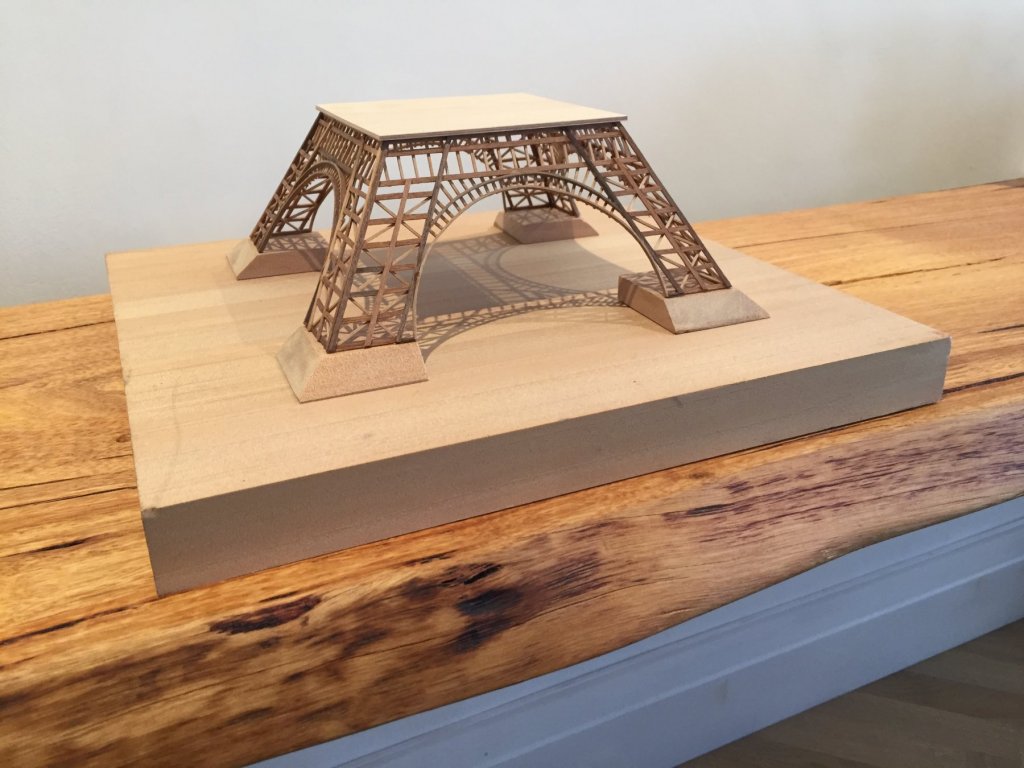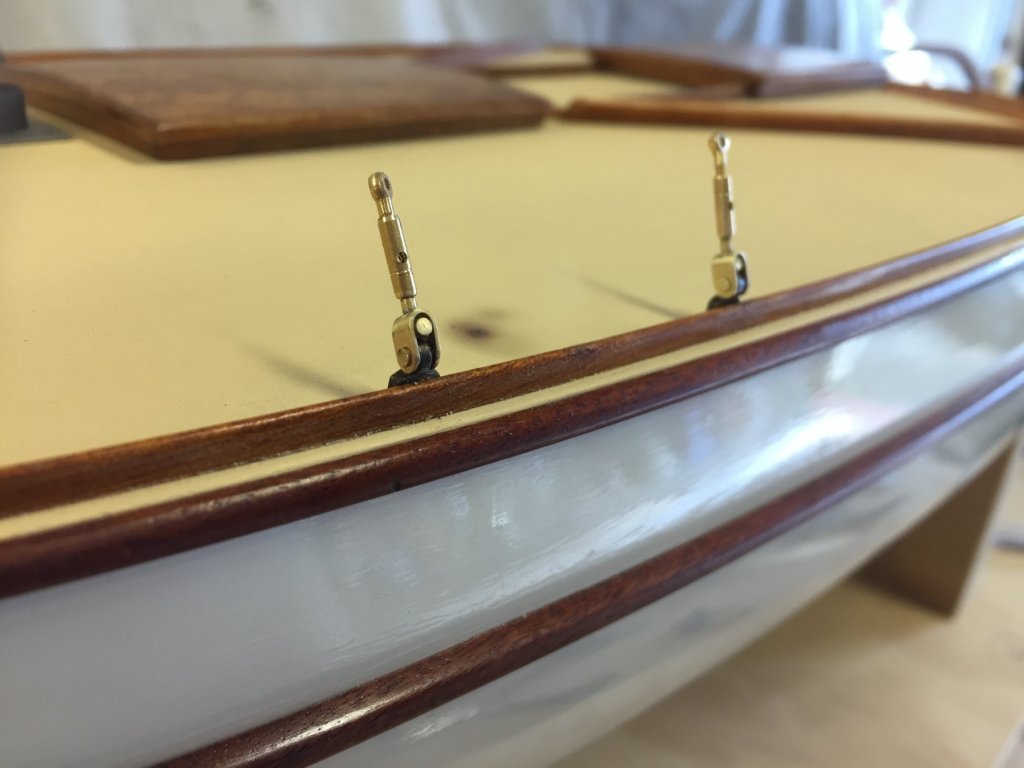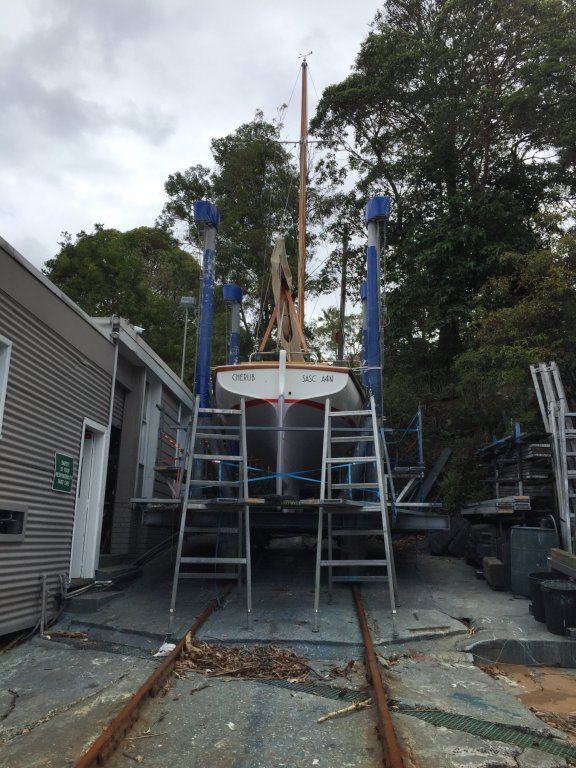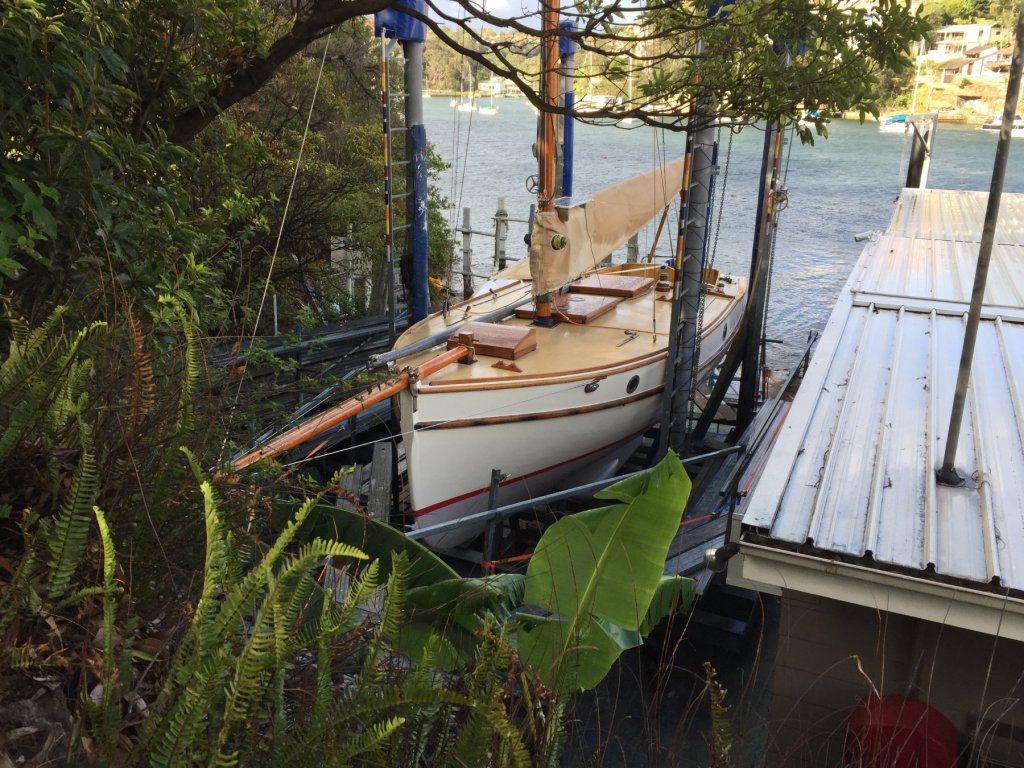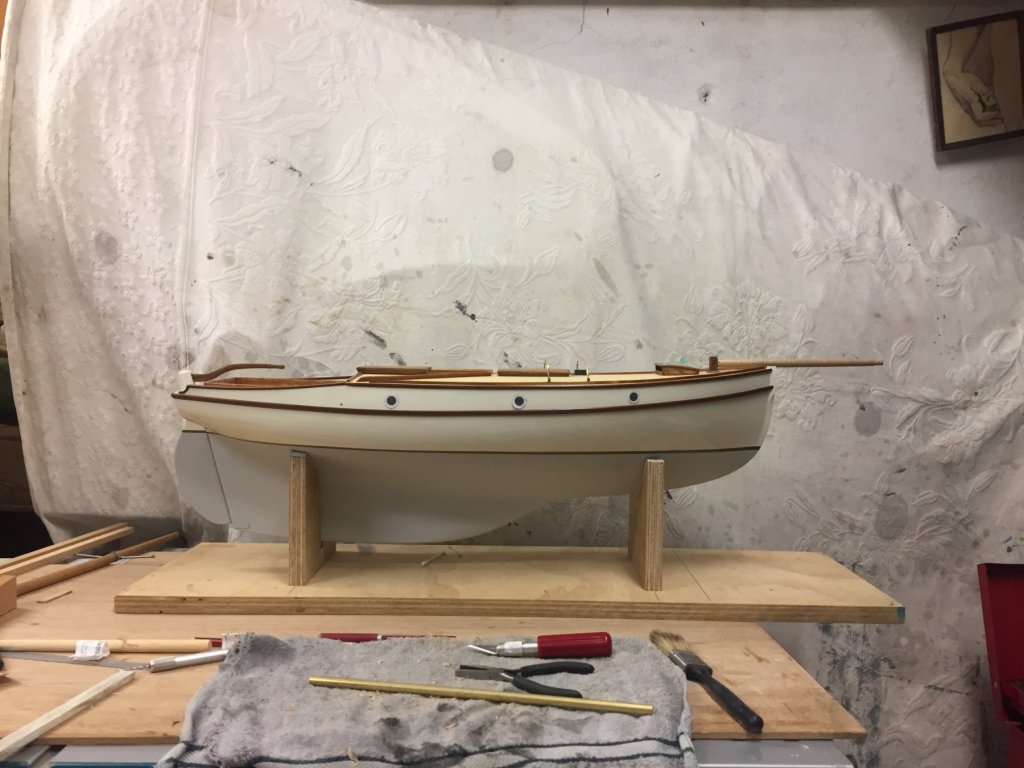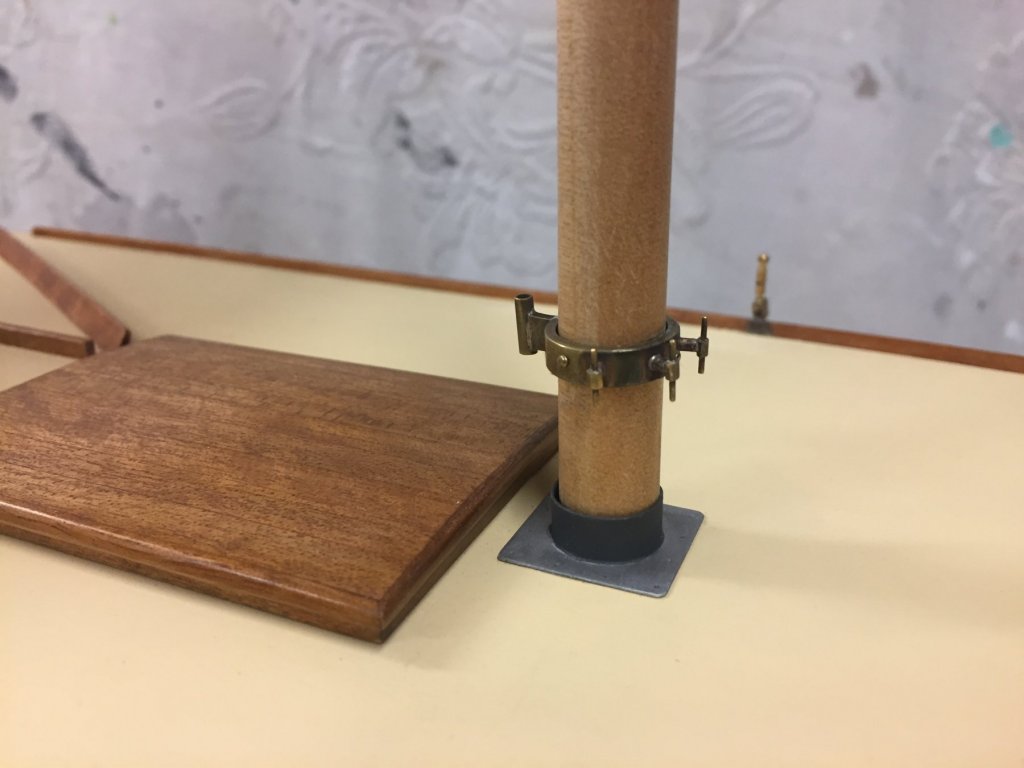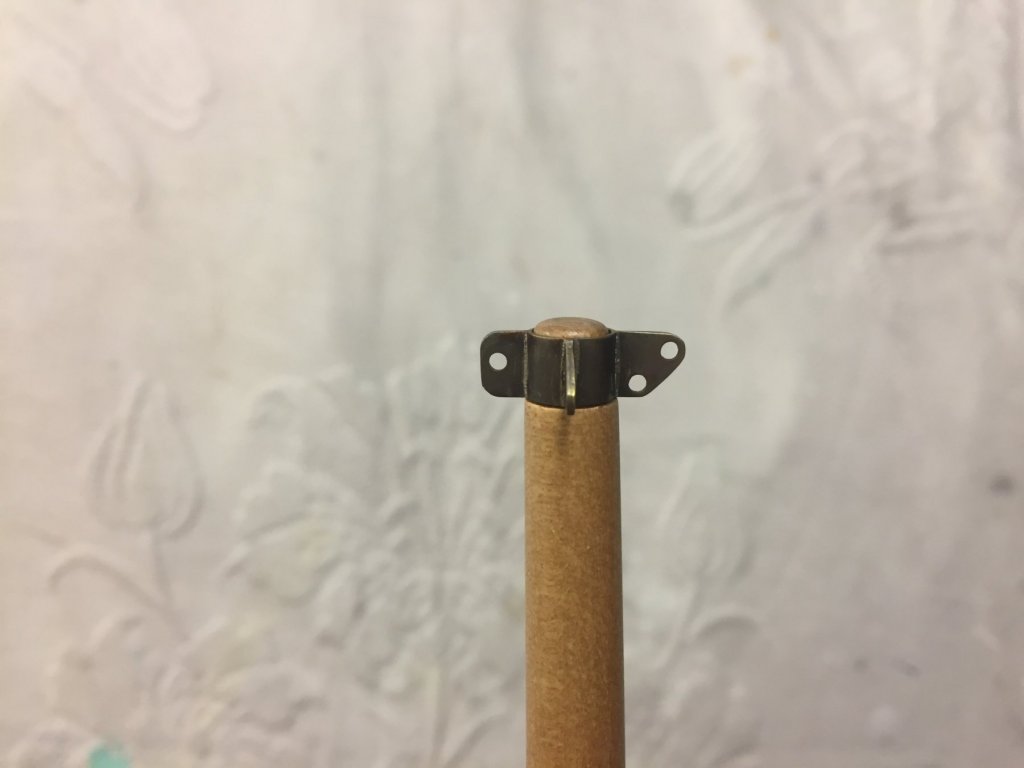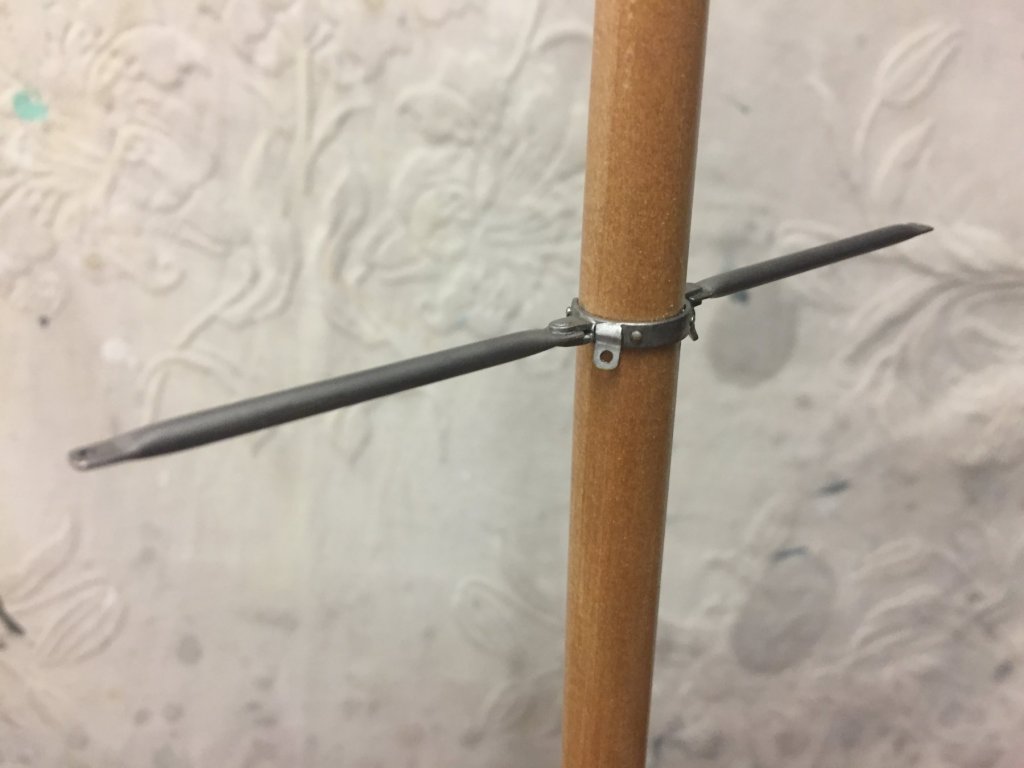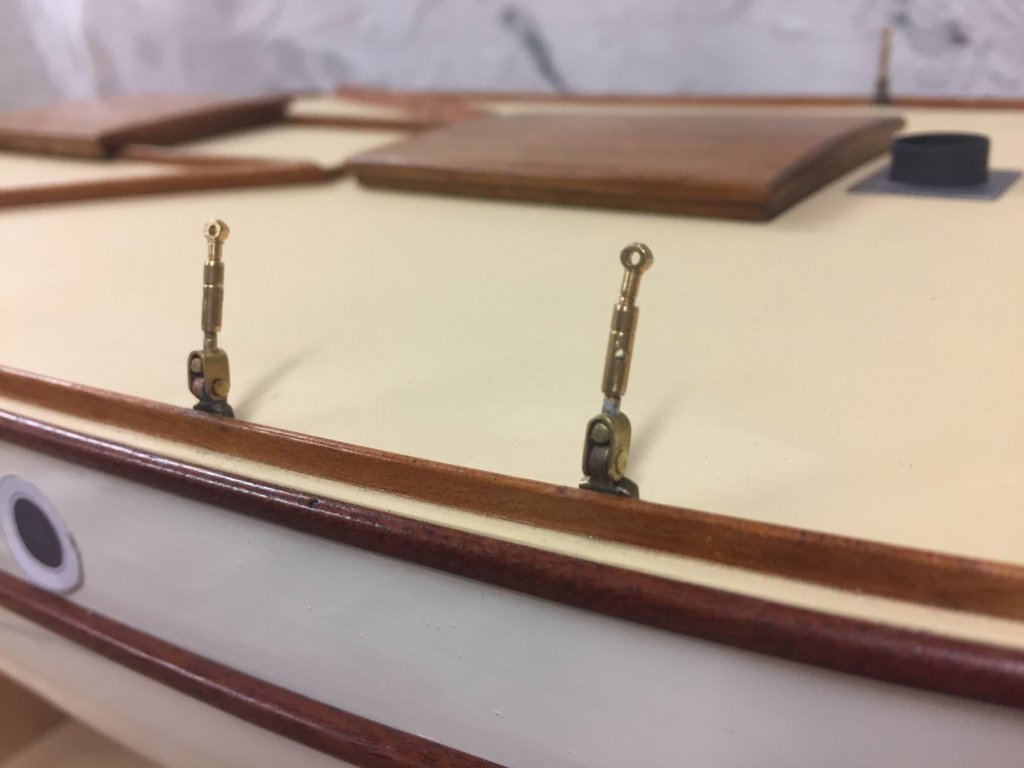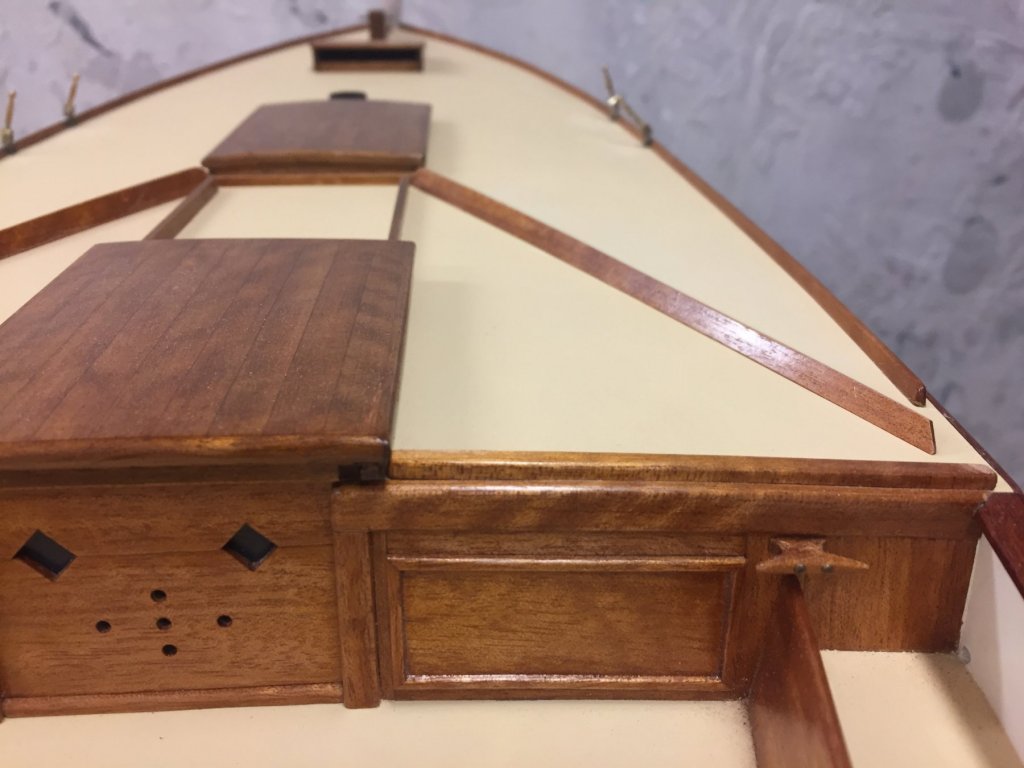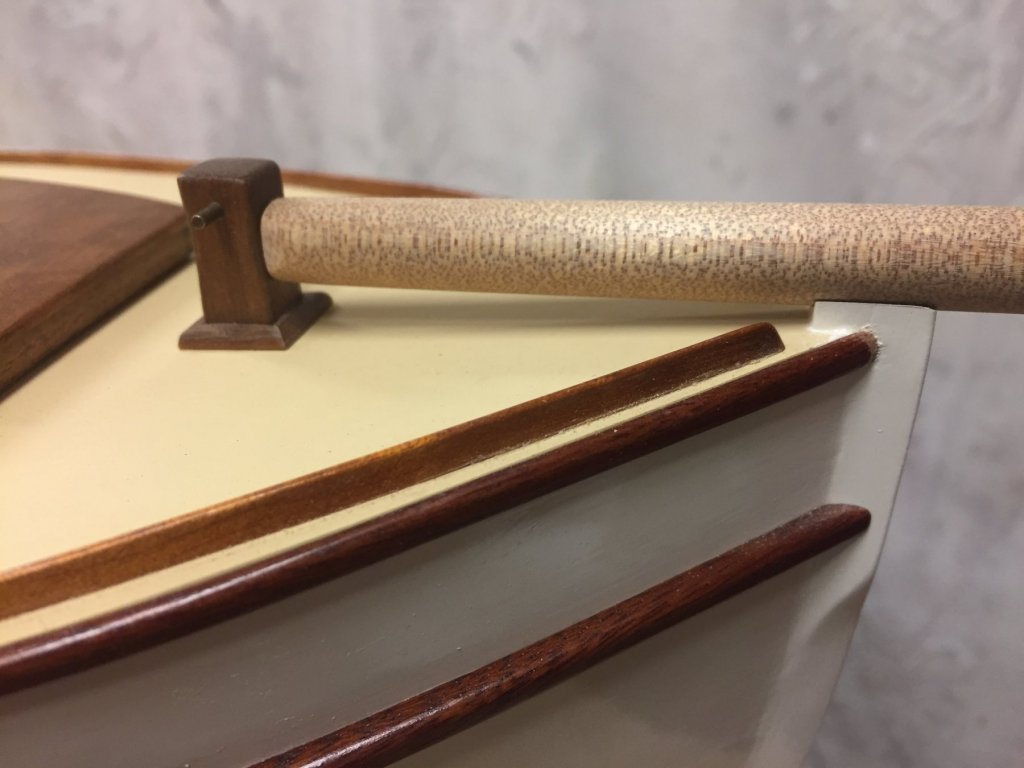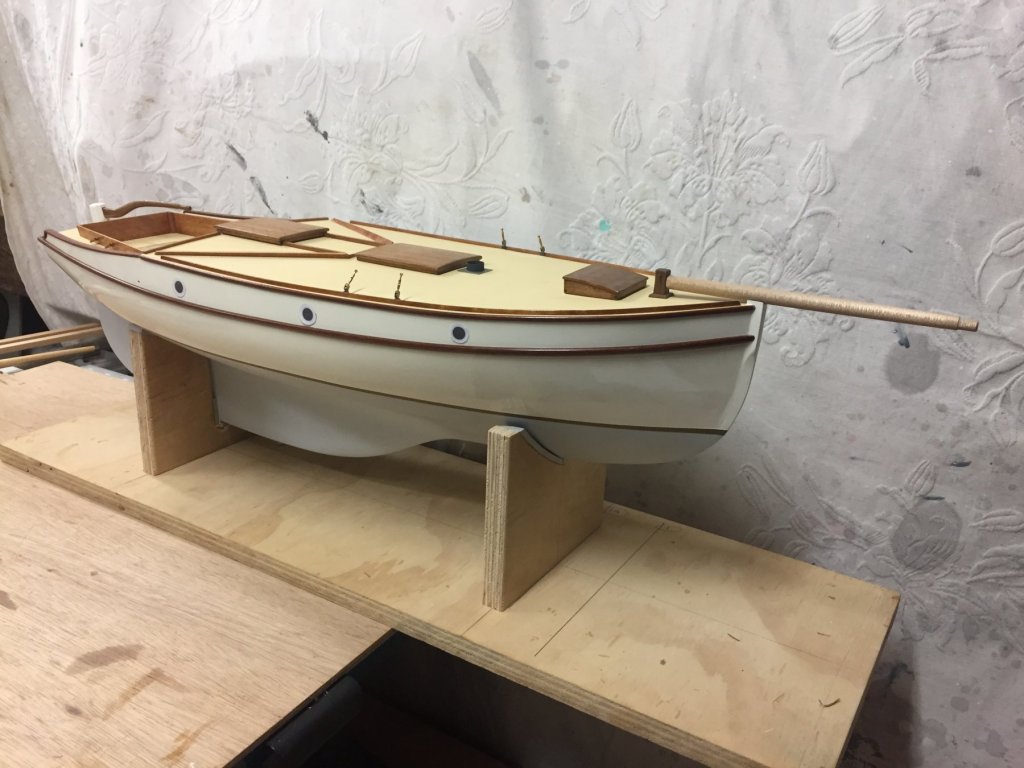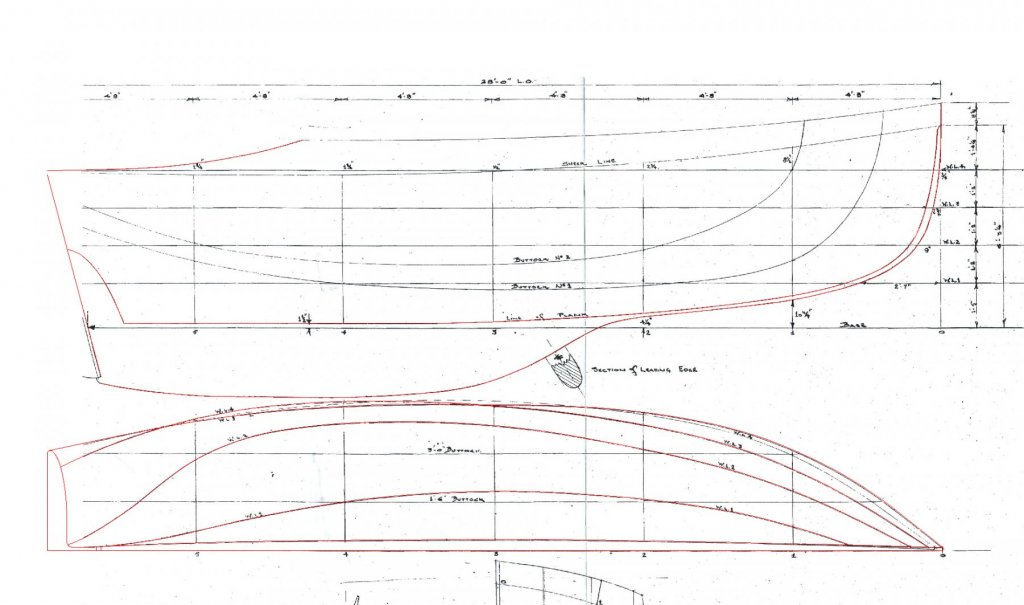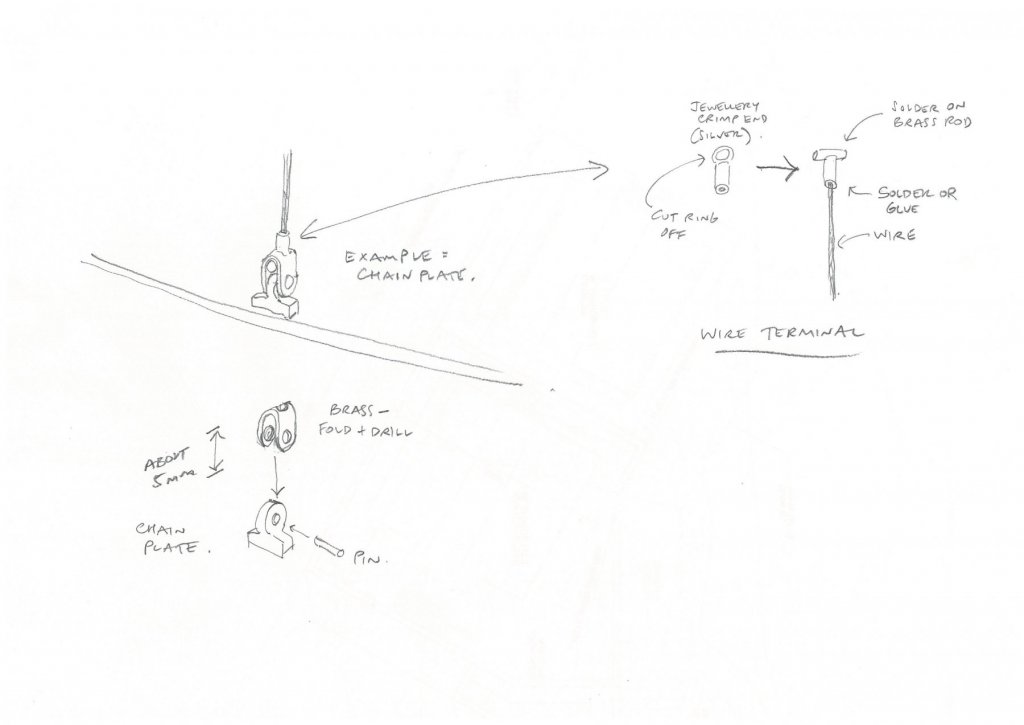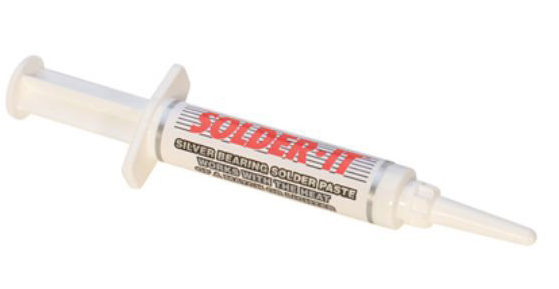-
Posts
822 -
Joined
-
Last visited
Content Type
Profiles
Forums
Gallery
Events
Everything posted by Mark Pearse
-
Hi Keith that's an elegant & original design idea, I look forward to seeing it develop. Mark
-
thanks John, a good suggestion & I that's what I did initially on my sketch drawing of the rig. However, Cherub's bowsprit is very long as it was lengthened by about 350mm when we converted her back to a gaff rig, to improve the balance on a rig that was larger than the original (with the mast position staying in place, a larger main was going to worsen a weather helm that in polite company is called "heavy"). When I saw that length on this model, I realised that it was almost certainly longer than what would have been in Cliff Gale's mind when he penned this last iteration of the design, & decided that I had better stick to a length that was more historically consistent. Mark
-
Hi everyone, I've been working on the model boat but haven't posted due to some other projects. Technical Advisor to my daughter on her build: & repainting the 1:1 boat: But on the model I've finished & mounted the gooseneck/spider band. The ageing of the brass is not entirely successful but can probably be improved by removing some. The mast cap, bow side on the right: & spreaders were painted silver to replicate SS. Not sure on that one either but we'll see Bowsprit is shaped. From drawings that I drew it was quite a bit longer, but when I made it that size it just didn't look right - so I reduced it by about 300mm actual size. The boat design drawings don't give rigging, but I reasoned that it could be longish as the boat was designed for harbour racing with picnicking & some near coastal cruising - but not 'romantically' long. There's the temptation to do it solely on looks, & there's not many things that beat the visual flourish that a nice bowsprit gives to a yacht....so it was one of those decisions. Anyway, this is what I came up with: I also reduced the height of the aft ends of the cutwaters, they were just too high, about 75mm actual is enough. It doesn't really show in the photo, but they taper downwards from the forward end. And after some biblical-grade trials, the detail connecting the (bought) turnbuckles to the chainplates was completed. I'm thinking of a simpler detail for most other shroud end details, where the wire terminates at a tang with a hole. Mark
-
Hello Hakan I look forward to this build, what a pretty boat. Looks like she'd sail well also. PS does the bowsprit have a bobstay? It's quite light & looks to be bending up in the book cover photo - Mark
-
Hi Vaddoc with the planking, the timber (Huon Pine) is very supple so it was happy to flex across the planks & I was able to push a plank up against the next one. If I understand correctly, 'crown height' is deck camber? ie: the amount of curve? If that's correct, then yes it's got pretty flat decks, just a slight camber. I measured the height on a similar boat & set up the curve based on that, & all the deck beams have the same radius. The decks also curve up slightly towards the bow, I was concerned that the plywood wouldn't want to do that double curve, but I used some minute screws that were strong enough to hold the curves down while the glue went off. The model scale is 1" to 1'. I got the deck shape from the half plan on the lines drawing, as copied below. Thanks for complement on the painting. The underwater paint is a water based acrylic, matt finish. It took a few coats, but my main recommendation is to get brushing thinners, it will help to keep a wet edge when you paint. Quality brushes help a lot too, I use synthetic sable flat brushes, one about 12mm wide & one about 6mm wide. Using brushing thinners is a balance between opacity & the extra time that you get to 'join' the new paint to the old. I used the same technique that you use on a full sized boat - a series of vertical applications, starting at the bow or stern. Where each of the vertical strips meets the next is where the brushing thinners will help to avoid a visible overlap of paint. Another suggestion is Tamiya masking tape is worth getting for the boot top line & any masking jobs. I'm actually painting our yacht this week, I'll post some photos when it's done. Hi Hakan, nice to meet you. Well spotted, yes this boat is similar. The boat is the Sydney/Hobert was launched in 1931 & is also 28', & both were designed by Cliff Gale, this yacht was designed in the mid 1960s but never built. Maluka was designed for ocean voyaging, with stiffer lines & more buoyancy in the bows so the bows. This yacht is the last version of this design that Cliff did & was primarily for harbour racing & some cruising, so needed only to be able to deal with medium offshore conditions. The introductory post for this build includes a couple of Maluka photos, & you can see how her keel is much deeper, & you might be able to see how how lines a much 'squarer' - to give additional righting moment from buoyancy. Thanks for your kinds comments on the metalwork, I'm struggling with the rigging still but will have something to show for it in a couple more weeks. Mark
-
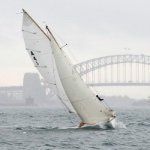
yacht rigging for 1:12 scale
Mark Pearse replied to Mark Pearse's topic in Masting, rigging and sails
sorry for the late reply to your comments - thanks both. MNL: the design is basically a 1930s design (maybe even old fashioned in the 1930s), but a variant that was tweaked in the 1960s, so the last iteration of an earlier old fashioned (but successful) design. I'm going to replicate SS wire shrouds, & probably rope for the backstays - I'm really not sure if anyone used rope then as backstays but all of the gaffers I know use rope, spectra etc. For a 28' boat it will have a lot of sail area, probably more than a Mumm/Farr 30, short fat heavy boats both need it & can handle it. Wallace2: Hi, thanks the model will be static. Since my last post above I've come across woven SS wire for jewellery, to scale at about 0.8mm diameter. Also, I have working turnbuckles that are nicely to scale. This is the progress, similar to the sketches but I integrated the bottom part of the turnbuckle with the rigging. The chain plates have also been done, as you can see. I'm happy with the result thanks, Mark -
Real silk is destroyed by UV light, it will literally fall apart - as you found.
- 749 replies
-
- albertic
- ocean liner
-
(and 2 more)
Tagged with:
-
Hi Keith I like the way you've used the heat-shrink on the rigging - could you tell me some details on the product? thanks, Mark
-
some progress: the shroud chain plates were finished & installed, & the mast base likewise. I was hoping to do a simple & well scaled way of terminating the shrouds at the chain plates. The initial idea was as per the sketch below, but it didn't include the turnbuckles. So I turned one end of the turnbuckle into the shaft of the T. Not quite finished, but it's a test run. thanks, Mark
-
Hi Vaddoc it sounds like the sanding sealer is the same thing as I meant. In your position I would consider doing the sealer & leaving the topcoat painting until you were sure that the movement had settled down. It's a big deal to do a final topcoat, & to wait a bit longer after doing the sealer coat might just mean the topcoat doesn't need to be redone. Best wishes for whatever you decide to do. Mark
-
HI Vaddoc she is looking good & will be a great model. Have you thought about undercoat paint in collaboration with the filling? I would think that filled, sanded & undercoated the timber will be more stable.....having filled the gaps, you don't want the timber to go back fully to its original dimensions either. And a good undercoat will sand well, so that if you do need to resand where some filler might be pressing out a little, you can easily do that. Mark
-
HI Vaddoc, very nice & looks almost real. How wide are the gaps between the planks? Mark
-

yacht rigging for 1:12 scale
Mark Pearse replied to Mark Pearse's topic in Masting, rigging and sails
thank you for your advice & comments, this has helped a lot Kurt, I'm guessing on around 8mm diameter actual size shrouds & stays, & that equates to about 0.03", & Beadalon has 0.76mm diameter which equates to about 9mm actual. My thought is to do something like the details sketched out below: use a standard silver jewellery crimp end & remove the ring, then solder a piece of solid brass rod into to T shape, & solder or crimp the wire into the crimp end (or glue). This fits into a folded joiner that's pinned to the chain plate eyes - or whatever it's being joined to. An option is to use brass tube instead of the crimp end, & see if I can get it to solder or glue well enough. see below, I think this will work. -

yacht rigging for 1:12 scale
Mark Pearse replied to Mark Pearse's topic in Masting, rigging and sails
thanks Keith, that does look good & there's a local supplier as well The metalwork & rigging on your Altair is beautiful, I love the attention to the scale of the details. Mark -

yacht rigging for 1:12 scale
Mark Pearse replied to Mark Pearse's topic in Masting, rigging and sails
thanks for that, I'll have a look Mark -

yacht rigging for 1:12 scale
Mark Pearse replied to Mark Pearse's topic in Masting, rigging and sails
thank you John, Art, that's great. I'm just wondering if there's a way of having the crimps .... look less like crimps & more in scale. I have a picture in my head of them & perhaps they are more sophisticated than I imagine. Do you ever solder it as a way to join or form an end? I'm wondering about soldering a small U shaped piece of brass to it, & then pin that U to a tang, plate, chain plate etc... Mark -
Hi all I'm building a 1:12 yacht model, the actual boat would be 28 foot hull (around 9m) & a 20th century yacht - so the shrouds would be wire perhaps 8 to 10mm diameter actual (or 0.65 to 0.8 or 1mm diameter to scale). The actual rigging would be stainless steel, so it would be nice for it to look like that. It needs to be straight when tensioned a bit, it won't look any good with kinks. Also, I think that some texture is preferable, to replicate the texture of the SS wire, but I'm open to solid... I'm be grateful for any suggestions, thanks Mark
-
Hi very lovely model & wonderful boats. A question: in an early photo the hull is massed up with bulkheads & solid blocking - is this the hull that you painted or did you line it off with thin surface planks? You said early on in the posts that there are none in existence? Perhaps there are no original ones left, but a friend from Sydney was involved this year in taking several historic 18 Sydney footers over to USA to race against some sandbaggers. See some information & photos here of the event, (& I am guessing that off centre harbour will do a video on it): https://www.sydneyflyingsquadron.com.au/8-footers-taking-on-the-usa/ https://www.facebook.com/AussieOpenBoat/photos/pcb.1698530063513134/1698525546846919/?type=3 https://smallboatsmonthly.com/2017/09/sydney-flying-squadron-visit-annapolis-md/ It is interesting that there were 22' & 24' skiffs here & from what you can see in the old photos they were really quite similar lines to your lovely model. all the best, very nice, Mark
-
thanks Carl, perhaps I'm one of the people (including drunks) that the gods protect from their own ignorance...I had no idea it might be tricky. I heated the plate from underneath & soldered from above. Hi John, appreciate you thoughts on that, I'll work something out to pin them. A small patch in the paint will be straightforward to repair.
-
I've shaped the mast, it's been sanded since this photo & one thin coat of varnish applied with a cloth & rubbed until satin finish. The timber is plantation Kauri Pine, lovely fine grain without pores & a good colour for this model. One interesting thing to note is that I bought some 12mm diameter dowel & it looked too thin, even though it was only a small amount under sized. So I made this one at 12.5 - 13mm diameter & it looks right. The mast step is to replicate the kind of fitting mostly used, at least here anyway - which is a roofing fitting called Dektite - designed to shed water on a metal roof around a circular flue. The idea is the brass gets painted dark grey (a rubber boot) & the plate is left silver (aluminium & rubber base). Bad news was that I didn't realise the metal was steel rather than stainless steel, the colour threw me because it has a sandblasted finish. It rusted a bit overnight, so I sanded it & put a coat of varnish on it. If that doesn't work then I'll just paint it grey. The chainplates for the mast shrouds are underway. I didn't plan the installation when building the hull, except to put a kind of sheer clamp in below the deck. I'll glue the chainplates in with epoxy, I think that will work.
-
thanks all, the positive character of this forum is very helpful in so many ways. Hi Keith, that's right I don't have many tools but it seems to be enough. Some years ago I built a sailing boat, & when starting wasn't sure what tools I would need so decided to only buy them when I couldn't do the job another way using an existing tool - & I've kept using that philosophy notwithstanding the pangs of looking through catalogues of delicious tools. I can understand the allure of beautiful machinery & learning how to get it purring - plus the amazing results that tools & knowledge together can bring - but this is my way I suppose. I couldn't do without the 10x vision headset. all the best, Mark
-
The spreaders are pretty much finished now, the arms are from 3mm brass tube flatten each end with soldered in the squashed end as a filler. Polished & shiny, but I'll likely dull them off to a brownish colour. from forwards, sitting on the stock that will be the mast from aft side, the lower shrouds fixing tangs visible thanks all
-
Hi Michael, to be honest, I thought I was silver soldering, but that's a more reliable indication of how little I know than anything else... The product I'm using proudly calls itself 'silver bearing solder' on the packet, but the company's webpage for the product doesn't seem to use the word silver http://www.harrisproductsgroup.com/en/Products/Alloys/Soldering/Lead-Free-Solders/Stay-Brite-Kit.aspx You're certainly correct that I can sand the solder afterwards & remove the excess quite easily with sandpaper & files, & am using a Dremel VersaTip butane torch. I also bought some silver bearing solder paste (image below of the product), I have been able to melt it but it's more difficult to get it to flow than the Harris product & I've not experimented enough with it. It would be good to know for certain, to clear it up both for myself & for the benefit of others. Mark
About us
Modelshipworld - Advancing Ship Modeling through Research
SSL Secured
Your security is important for us so this Website is SSL-Secured
NRG Mailing Address
Nautical Research Guild
237 South Lincoln Street
Westmont IL, 60559-1917
Model Ship World ® and the MSW logo are Registered Trademarks, and belong to the Nautical Research Guild (United States Patent and Trademark Office: No. 6,929,264 & No. 6,929,274, registered Dec. 20, 2022)
Helpful Links
About the NRG
If you enjoy building ship models that are historically accurate as well as beautiful, then The Nautical Research Guild (NRG) is just right for you.
The Guild is a non-profit educational organization whose mission is to “Advance Ship Modeling Through Research”. We provide support to our members in their efforts to raise the quality of their model ships.
The Nautical Research Guild has published our world-renowned quarterly magazine, The Nautical Research Journal, since 1955. The pages of the Journal are full of articles by accomplished ship modelers who show you how they create those exquisite details on their models, and by maritime historians who show you the correct details to build. The Journal is available in both print and digital editions. Go to the NRG web site (www.thenrg.org) to download a complimentary digital copy of the Journal. The NRG also publishes plan sets, books and compilations of back issues of the Journal and the former Ships in Scale and Model Ship Builder magazines.



